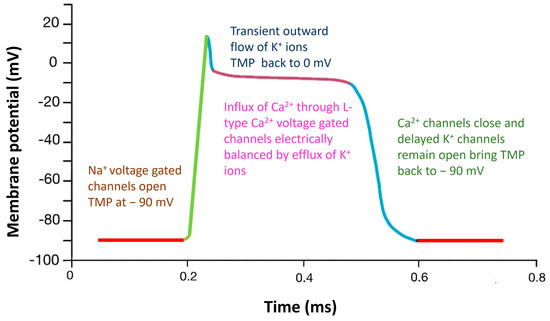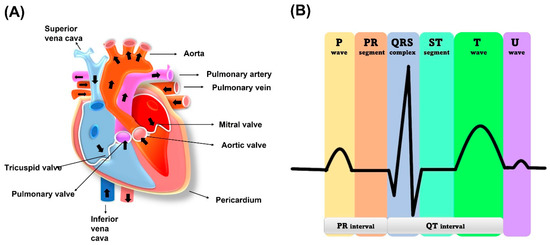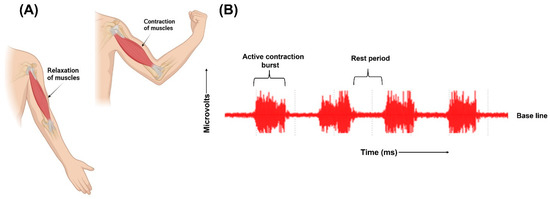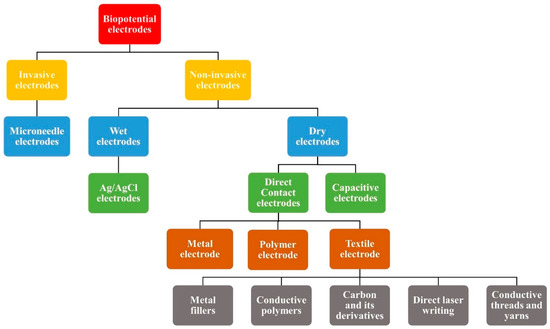You're using an outdated browser. Please upgrade to a modern browser for the best experience.
Please note this is a comparison between Version 1 by Jitendra Pratap Singh and Version 2 by Lindsay Dong.
The technology of wearable medical equipment has advanced to the point where it is now possible to monitor the electrocardiogram and electromyogram comfortably at home. The transition from wet Ag/AgCl electrodes to various types of gel-free dry electrodes has made it possible to continuously and accurately monitor the biopotential signals. Fabrics or textiles, which were once meant to protect the human body, have undergone significant development and are now employed as intelligent textile materials for healthcare monitoring. The conductive textile electrodes provide the benefit of being breathable and comfortable.
- wearable electronics
- textile electrode
- dry electrodes
- smart textiles
- electrocardiogram
- electromyogram
- biopotentials
1. Introduction
Wearable biopotential signal monitoring is a promising technology that has gained significant attention in recent years owing to its potential to revolutionize healthcare by enabling continuous and non-invasive monitoring of human physiological signals. Instead of the cumbersome healthcare systems used in hospitals, it is now possible to monitor patients’ health at home at their convenience and to improve healthcare facilities and treatment in separate locations due to the miniaturization of electronic devices [1][2][1,2]. Wearable electronics make it feasible to track patients’ health status and keep an eye on their medical issues over a prolonged length of time. Wearables can be used to treat neuromuscular ailments, fatal cardiovascular conditions, muscle-building for sports, and anomalies connected with the brain and at rehabilitation facilities [3][4][5][3,4,5]. Cardiovascular disease, the major cause of death across the globe, in which the ischemic disease, which is the leading cause of cardiovascular disease, alone was responsible for 9.44 million deaths in 2021 [6]. The early detection and management of CVD can significantly improve patient health and reduce the medical expenses. Hence, wearable biopotential signal monitoring are an an effective tool for early detection and monitoring of CVD as well as other health conditions, such as sleep disorders, epilepsy, and Parkinson’s disease [7][8][9][7,8,9].
Previously used only for clothing, textiles have transformed into smart textiles, which have a variety of applications, including temperature, pressure, strain, and motion sensing [10][11][12][13][10,11,12,13]. Due to the comfort that clothing offers, it may be simpler if the measuring device is incorporated into the clothing so that patients can wear it without any restrictions and without the need for special skin preparations [14]. Additionally, textile materials are freely accessible, which lowers manufacturing costs. Due to their distinctive qualities, including flexibility, breathability, and washability, textile electrodes are a promising technology for wearable biopotential signal monitoring [15][16][15,16]. Reusable electrodes will be more economically feasible for the long-term monitoring of biopotentials. Textile electrodes are therefore preferable to commercial wet electrodes made of Ag/AgCl that cannot be reused. Since the gel in commercial wet electrodes might get dehydrated and reduce the signal quality, they cannot be utilised for extended periods of time [17].

2. Biopotentials
Biopotentials are electrical signals produced by excitablecells like the neurons and cardiac cells and tissues as a result of the movement of charged particles like ions across cell membranes. The difference in electrical potential between the interior and the exterior of the cell as a result of ion transport across the cell membrane generates the electrical signals which are measurable in millivolts. These electrical potentials known as biopotentials travel towards the body’s surface, which serves as a conductor of volume [18][19][23,24]. Using electrodes positioned on the skin or directly on the tissue of interest, this electrical potential can be recorded. In disciplines such as cardiology, neurology, and sports science, biopotentials are frequently employed for diagnostic and research purposes since they can reveal important information about the physiological status of cells and tissues [20][25]. Collecting and analysing these signals help in understanding of the functioning of the body’s organs and abnormalities associated with them. The movement of sodium, potassium, and calcium ions across the voltage-gated channels are responsible for the propagation of action potentials through the heart and muscles. The resting membrane potential of −90 mV is raised to more positive values during depolarization, and the cell potential value is restored during repolarization [21][26]. The mechanism of voltage mediated ion transport across the cell membrane, resulting in the action potential curve in the depolarization–repolarization cycle, is illustrated in Figure 1.
Figure 1.
Action potential curve which illustrates the change in membrane potential during ion diffusion in cardiac myocytes.
2.1. Electrocardiogram (ECG)
The human heart is a vital organ that pumps blood to the entire body. It is divided into four chambers, with the two upper chambers called atria and the two lower chambers called ventricles, as shown in
Figure 2. Blood flows from the atria to the ventricles through an atrioventricular septum, which separates them. The heart’s contraction is what moves blood throughout the body. The muscles surrounding the atria and ventricles contract, squeezing the blood down and out of the heart. The heart has valves that ensure blood flows in one direction. The tricuspid valve is between the right atrium and right ventricle while the mitral valve regulates blood flow between the left atrium and left ventricle. Blood is received by the heart through two main veins, the superior vena cava and inferior vena cava, which bring in deoxygenated blood from the body. After the blood is pumped out of the right ventricle, it travels to the lungs through the pulmonary valve and artery. At the lungs, blood is oxygenated and returns to the left atrium via the pulmonary vein. The left ventricle then pumps the oxygenated blood throughout the body. The cardiac muscle in the left ventricle wall is thicker than the right ventricle wall because it needs to pump blood throughout the entire body [22].
. Blood flows from the atria to the ventricles through an atrioventricular septum, which separates them. The heart’s contraction is what moves blood throughout the body. The muscles surrounding the atria and ventricles contract, squeezing the blood down and out of the heart. The heart has valves that ensure blood flows in one direction. The tricuspid valve is between the right atrium and right ventricle while the mitral valve regulates blood flow between the left atrium and left ventricle. Blood is received by the heart through two main veins, the superior vena cava and inferior vena cava, which bring in deoxygenated blood from the body. After the blood is pumped out of the right ventricle, it travels to the lungs through the pulmonary valve and artery. At the lungs, blood is oxygenated and returns to the left atrium via the pulmonary vein. The left ventricle then pumps the oxygenated blood throughout the body. The cardiac muscle in the left ventricle wall is thicker than the right ventricle wall because it needs to pump blood throughout the entire body [27].


Figure 2. (A) Human heart schematic representation. (B) ECG standard waveform from human heart.
The contraction of the heart is a crucial step in the circulation of blood throughout the body. This contraction process is controlled by the propagation of electrical signals induced by cation exchange through the heart cells [23].
The contraction of the heart is a crucial step in the circulation of blood throughout the body. This contraction process is controlled by the propagation of electrical signals induced by cation exchange through the heart cells [28].
The electrical activity of the heart that generates the ECG signal is produced by the depolarization and repolarization of cardiac muscle cells. When the heart muscle cells depolarize, they become more positively charged, creating a small electrical current that can be detected on the surface of the skin. The sinoatrial (SA) node is known as a natural pacemaker of the heart. The SA node is located in the wall of the right atrium, as shown in
Figure 2
.
The electrical activity of the heart can be described in terms of the principles of electrophysiology. This field of study examines the electrical properties of biological cells and tissues and how they relate to the function of the body. The principles of electrophysiology are based on the laws of physics, including Ohm’s law, which describes the relationship between current, voltage, and resistance, and the principles of electrical capacitance and inductance. By applying these principles, researchers can gain a better understanding of the electrical activity of the heart and how it can be measured and analysed to diagnose heart conditions [21].
The electrical activity of the heart can be described in terms of the principles of electrophysiology. This field of study examines the electrical properties of biological cells and tissues and how they relate to the function of the body. The principles of electrophysiology are based on the laws of physics, including Ohm’s law, which describes the relationship between current, voltage, and resistance, and the principles of electrical capacitance and inductance. By applying these principles, researchers can gain a better understanding of the electrical activity of the heart and how it can be measured and analysed to diagnose heart conditions [26].

2.2. Electromyogram (EMG)
The human body has both smooth and skeletal muscles. The skeletal muscles are responsible for the movements of the body. The skeletal muscles are composed of numerous fibres. Each of these fibres are made of smaller subunits called myofibrils ranging from hundreds to thousands. Each myofibril is composed of many myosin filaments, which are large, polymerized protein molecules responsible for the actual muscle contraction. These nerve fibres innervate the skeletal muscle fibres, and the action potential is initiated in the muscle fibre by the nerves. A single motor nerve fibre and all the muscle fibres it innervates comprise a motor unit. The origin and execution of muscle contraction begins when the action potential travels along a motor nerve to its ending on the muscle fibres. Neurotransmitter acetylcholine is released at the nerve ending. This leads to the diffusion of large quantities of sodium ions into the interior of the muscle fibre membrane through the acetylcholine-gated channels. Depolarization occurs, leading to opening of voltage-gated sodium channels initiating action potential at the membrane. It depolarizes the muscle membrane, and action potential electricity flows through the centre of muscle fibre. Calcium ions are released from the sarcoplasmic reticulum, which initiates attractive forces between the actin and myosin filaments, causing them to contract. After a fraction of a second, the calcium ions are pumped back and stored until a new muscle action potential is initiated. The removal of calcium ions causes the relaxation of the contracted muscles. This depolarization–repolarization cycle forms an electric dipole and travels through the surface of the muscle fibre. The movement of ions generates electrical potential in the muscle cells which travels along the surface of muscle fibre [21]. Electrodes placed on the surface of the skin records this electrical activity. The electrodes detect the superposition of all active motor units that can be detected under the bipolar electrode configuration site. Recording the electrical activity of the muscles and using it for clinical examination or for athletics training is called electromyography [20][24].
The human body has both smooth and skeletal muscles. The skeletal muscles are responsible for the movements of the body. The skeletal muscles are composed of numerous fibres. Each of these fibres are made of smaller subunits called myofibrils ranging from hundreds to thousands. Each myofibril is composed of many myosin filaments, which are large, polymerized protein molecules responsible for the actual muscle contraction. These nerve fibres innervate the skeletal muscle fibres, and the action potential is initiated in the muscle fibre by the nerves. A single motor nerve fibre and all the muscle fibres it innervates comprise a motor unit. The origin and execution of muscle contraction begins when the action potential travels along a motor nerve to its ending on the muscle fibres. Neurotransmitter acetylcholine is released at the nerve ending. This leads to the diffusion of large quantities of sodium ions into the interior of the muscle fibre membrane through the acetylcholine-gated channels. Depolarization occurs, leading to opening of voltage-gated sodium channels initiating action potential at the membrane. It depolarizes the muscle membrane, and action potential electricity flows through the centre of muscle fibre. Calcium ions are released from the sarcoplasmic reticulum, which initiates attractive forces between the actin and myosin filaments, causing them to contract. After a fraction of a second, the calcium ions are pumped back and stored until a new muscle action potential is initiated. The removal of calcium ions causes the relaxation of the contracted muscles. This depolarization–repolarization cycle forms an electric dipole and travels through the surface of the muscle fibre. The movement of ions generates electrical potential in the muscle cells which travels along the surface of muscle fibre [26]. Electrodes placed on the surface of the skin records this electrical activity. The electrodes detect the superposition of all active motor units that can be detected under the bipolar electrode configuration site. Recording the electrical activity of the muscles and using it for clinical examination or for athletics training is called electromyography [25,30]. Figure 3
illustrates the contraction and relaxation of muscles and the recording of raw EMG signals.

Figure 3. (A) Representation of contraction and relaxation of muscles. (B) Graphical representation of raw EMG signals.
The signals recorded by the electrodes are raw, unfiltered EMG signals. Relaxed muscles are recorded as a less noise-free EMG baseline while on the contraction of the muscles, the signals are recorded as random non-reproducible amplitude spikes since motor units detected each time by the electrodes are not constant. Raw EMG signals range from −5 millivolts to 5 millivolts with a frequency range between 6 Hz to 500 Hz [24].
The signals recorded by the electrodes are raw, unfiltered EMG signals. Relaxed muscles are recorded as a less noise-free EMG baseline while on the contraction of the muscles, the signals are recorded as random non-reproducible amplitude spikes since motor units detected each time by the electrodes are not constant. Raw EMG signals range from −5 millivolts to 5 millivolts with a frequency range between 6 Hz to 500 Hz [30].
Recording EMG signals can help in understanding muscle fatigue, which is the decrease in the maximum contraction capability of specific muscles [25]. For a subject with muscle fatigue, there is a decrease in the fibre conduction velocity, with a diminishing number of fast contracting motor units. This results in shift of EMG power spectrum towards lower frequencies and the amplitude of the signals can increase because of the recruitment of additional motor units and their growing firing rates to sustain the required force. Textile electrodes are successful in monitoring EMG muscle fatigue monitoring. Graphene textile electrodes, which were fabricated with a dip–dye–reduce cycle on nylon fabric, were sewn onto elastic bands, which ensure sufficient pressure for skin electrode coupling. The textile electrodes placed on bicep brachii muscles successfully recorded the signals shifted to a lower frequency and increased amplitude, proving textile electrodes have the potential to be used in muscle fatigue monitoring, replacing the wet electrodes [26].
Recording EMG signals can help in understanding muscle fatigue, which is the decrease in the maximum contraction capability of specific muscles [31]. For a subject with muscle fatigue, there is a decrease in the fibre conduction velocity, with a diminishing number of fast contracting motor units. This results in shift of EMG power spectrum towards lower frequencies and the amplitude of the signals can increase because of the recruitment of additional motor units and their growing firing rates to sustain the required force. Textile electrodes are successful in monitoring EMG muscle fatigue monitoring. Graphene textile electrodes, which were fabricated with a dip–dye–reduce cycle on nylon fabric, were sewn onto elastic bands, which ensure sufficient pressure for skin electrode coupling. The textile electrodes placed on bicep brachii muscles successfully recorded the signals shifted to a lower frequency and increased amplitude, proving textile electrodes have the potential to be used in muscle fatigue monitoring, replacing the wet electrodes [32].

3. Biopotential Electrodes
3.1. Different Categories of Biopotential Electrodes
There are several types of biopotential electrodes depending upon the skin to electrode interaction, such as invasive and non-invasive electrodes. Invasive electrodes such as needle electrodes are typically used for deeper biopotential measurements such as intramuscular EMG. They penetrate the stratum corneum layer of the skin, which is the most resistive layer of the skin and hence the skin contact impedance is very low [27]. Different types of non-invasive electrodes are also used for ECG and EMG signal analysis. Surface electrodes used for non-invasive biopotential monitoring can be categorized into wet and dry electrodes, based on their charge transfer mechanism with the skin.
There are several types of biopotential electrodes depending upon the skin to electrode interaction, such as invasive and non-invasive electrodes. Invasive electrodes such as needle electrodes are typically used for deeper biopotential measurements such as intramuscular EMG. They penetrate the stratum corneum layer of the skin, which is the most resistive layer of the skin and hence the skin contact impedance is very low [39]. Different types of non-invasive electrodes are also used for ECG and EMG signal analysis. Surface electrodes used for non-invasive biopotential monitoring can be categorized into wet and dry electrodes, based on their charge transfer mechanism with the skin. Figure 4
represents the various kinds of biopotential electrodes.

Figure 4. Classification of different types of biopotential electrodes.
Dry contact electrodes have direct contact with the skin surface. The absence of gel leads to a high skin contact impedance. Different kinds of direct contact dry electrodes are metal electrodes, contact penetrating electrodes, polymer electrodes, and textile electrodes [34][48]. Electrodes with microneedles can overcome the challenge of a high skin contact impedance since their microneedle array at the surface of the electrode can penetrate the stratum corneum, which is highly insulating in nature [35][49]. Metal electrodes have better conductivity, are durable, and can be reused, but they are rigid and do not have good conformance with the skin. This can lead to the movement of the electrodes when the patient moves and can result in distorted signals and low SNR [33][46]. Taking into consideration for the importance of the skin conformance of the electrode for a reduced motion artefact and good signal quality, flexible dry electrodes were investigated. Polymer and textile electrodes are good choices of the materials, which can give better skin conformance.
3.2. Wet Electrodes
Wet electrodes have a layer of gel between the electrode and skin interface. They are non-polarizable electrodes, where there is a charge transfer occurring in the electrolytic medium from chemical reactions [19][28]. The chemical reaction that occurs at the electrode–electrolyte interface for charges to cross the interface can be represented as follows:
Wet electrodes have a layer of gel between the electrode and skin interface. They are non-polarizable electrodes, where there is a charge transfer occurring in the electrolytic medium from chemical reactions [24,40]. The chemical reaction that occurs at the electrode–electrolyte interface for charges to cross the interface can be represented as follows:
C ⇋ Cn+ + ne−
Am− ⇋ A + me−
The above reactions represent the oxidation dominating at the electrode–electrolyte interface. The atoms of the metal can get oxidized, and they give up their electrons, which goes to the electrode while the atoms oxidized enter the solution as cations. In addition, the cations coming from the gel can become oxidized and then give their electrons to the electrode while depositing on the electrode as a neutral atom. Reverse reactions also occur at the interface. These oxidation and reduction reactions are responsible for the transduction of an ionic current to electronic current at the electrode skin interface [29].
The above reactions represent the oxidation dominating at the electrode–electrolyte interface. The atoms of the metal can get oxidized, and they give up their electrons, which goes to the electrode while the atoms oxidized enter the solution as cations. In addition, the cations coming from the gel can become oxidized and then give their electrons to the electrode while depositing on the electrode as a neutral atom. Reverse reactions also occur at the interface. These oxidation and reduction reactions are responsible for the transduction of an ionic current to electronic current at the electrode skin interface [38].
